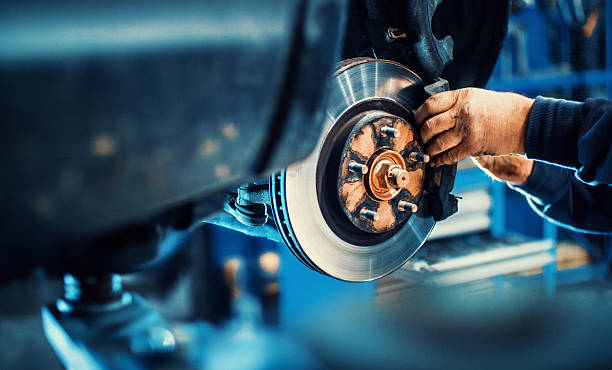Steps to Inspect & Replace Car Brake Pads at Home in Dubai
Read Sina Tyres Guide, and you can do your brake job if you’ve done some basic wrenching, such as repairing starting motors, alternators, or even dampers. You may not think about your brake pads, but you rely on them every time you press down the brake pedal. Brake pads in good working order are an essential aspect of your car’s braking system. You won’t have complete stopping strength if your brake pads are thin and worn out when you need them most.
Check your brake pads for signs of wear to ensure your safety and the safety of your passengers. You’ll discover little problems before they turn into brake failure. Your brake pads can check at home. Follow the simple instructions below to do the car brake pads replacement at home.
What Does It Mean to Replace Brake Pads?
Your vehicle’s braking system includes car brake pad replacement inside the brake caliper. The caliper applies pressure to the brake pads when you apply braking pressure. Your tyres will be slowed by the brake pads clamping down on the brake disc.
Every time you use your brakes, the brake pads become thinner and thinner. They will eventually need to replace to keep your braking system in good working order. The worn-down brake pads are removed and replaced with fresh pads during a car brake pads replacement.
Why Should You Replace Your Brake Pads?
If your brake pads are screeching or grinding, it’s probably time to replace them. You’ll be pleased to learn that you can change the pads in your car’s disc braking system without any special tools. Doing it yourself will also save you a lot of money. Even if you don’t want to do the work yourself, knowing what’s involved can help you understand what your technician may say in the future.
Front disc brakes are now standard on nearly all automobiles. Front car brake pads replacement typically wears down faster than rear brake pads, necessitating more frequent replacement. When brake pads become too thin, especially if they begin to make a continuous metallic squealing or grinding noise when you push the brake pedal, you should replace them. However, noise isn’t always the best indicator, so monitoring the thickness of the pads will help you predict when this will happen.
Required equipment
- Disposable mechanic’s gloves to protect and clean your hands.
- The jack and the jack stand.
- Wrench for lugs.
- To retract the piston, use a C-clamp or a length of wood.
- Wrench
- Draw out brake fluid with a turkey baster.
- Plastic ties, bungee cords, or a piece of string are all excellent options.
Necessary materials
Brake Pads
You’re saving money by completing the car brake pads replacement yourself; you might want to consider splurging on the more expensive original manufacturer brake pads.
Car Brake Fluid
Check your owner’s manual for the correct type of brake fluid.
The Process of Car Brake Pads Replacement
Here is the process of car brake pads replacement at home:
Step # 1 Remove The Wheel
Remove the lug nuts from the wheel and loosen them. Then jack up the vehicle and position a jack stand beneath the frame. Reduce the weight of the floor jack so that it rests on the jack stand. Remove the wheel and the lug nuts altogether. You can now securely reach beneath the car and access the brake assembly.
Step # 2 Remove Slider Bolt
The arrows in the image above point to them. The lower bolt is usually the only one that has to remove. It may be long, but it will effortlessly glide out once adequately loosened.
Step # 3 Raise The Brake Caliper
The brake caliper pivots up when the bottom bolt is removing. Do not detach any hydraulic brake lines since the rubber hose, which is the hydraulic line, will stretch to allow this. You’re doing something incorrect if you think you need to disconnect a brake line, you’re doing something incorrectly. Replace the brakes or seek professional assistance in car brake pad replacement.
It’s simple to check the thickness of the brake pads to see if they need to replace. Metal wear indicators, which are little metal tabs that squeak when they contact the rotors, are found on most brake pads. The pads are wear and tear if the friction material is one-eighth of an inch thick or less at any point, even if they are not yet touching.
Step # 4 Remove The Worn Brake Pads
The brake pads are now exposed, and the retaining clamps are only holding them in place weakly. Slide the old brake pads out of the way.
Replace The Holding Clips
New pads nearly always come with new clips, making it easy to move the pads back and forth. Replace the old ones with the new ones. The clips do not have any holding screws. They just click into place. There are generally left-handed and right-handed clips, so switch them out one at a time, ensuring sure they line up perfectly.
The brake pads will come with a little package of graphite-based lubricant. To protect the new brake pads from squeaking, apply lubricant to the clips.
The thin metal plate on the new brake pad is welded. Some brake pads may have loose shims that must keep until the pads are locked in place. The metal tabs on either end of the brake pad are known as the “ears.” These ears fit into the clips’ slots. Some grease can also lubricate the gears and any loose metal shims.
Step # 5 Replace The Brake Pads
The new car brake pads replacement is just as quickly as the old ones when they first arrived. However, the new clips are occasionally tighter. The new pads’ ears should fit snugly into the brake oil you’ve applied.
Step # 6 Pull The Pistons Back
These pistons squeeze the rotor and press on the brake pads to stop the car. Although each wheel on your car may only have one piston, the idea remains the same. These pistons must be retracted (pushed back) before the caliper can lower into place to clear the new, thicker brake pads.
Step # 7 Keep Track of the Brake Fluid Level
The braking fluid level gradually rises as the pistons push back. Check the master cylinder reservoir frequently. It is more of a worry when working on the second brake because the total fluid volume of two calipers can cause the brake fluid to overflow. If this appears to be the case, use a turkey baster to extract some of the brake fluid. There was a greater risk of spilling if topped off the fluid level during routine service visits. As the pads wear out, the fluid level naturally decreases. When it comes back up, the car brake pads replacement
Step # 8 Adjust The Caliper
The caliper should easily slide over the pads with the pistons retracted. The caliper may move on the newly installed brake pads if the fit is too tight. If the pistons snag on the brake pads, double-check that you have fully retracted the piston.
Step # 9 Replace The Slider Bolt If Necessary
Replace the slider bolt and tighten it again. Remount the tyre and tighten the lug nuts after straightening the car’s wheels.
Step # 10 Repeat On the Opposite Side
Repeat the procedure on the other side of the front brakes for car brake pads replacement. Keep in mind that the braking fluid level in the reservoir will be higher now that new pads put on one side, so keep an eye on it as you retract the piston on the other side. The fluid will surge even higher the second time. Because brake fluid is highly corrosive, you don’t want it to overflow.
Step # 11 Test Drive in A Safe Environment
Test-drive the car in a safe environment after car brake pads replacement to ensure that everything is in working order, paying specific attention to the first few stops. Keep in mind that your brake pedal may have a higher engagement point. You’ll adjust to the adjustment soon. Enjoy your new brakes, knowing they have thick brake pads to stop you safely.
Conclusion
Follow Sina Tyres Guide for Car Brake Pads Inspection and Replacement; and you will be perfectly able to change, inspect or repair your brake pads by yourself.

